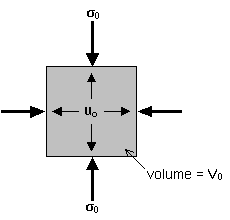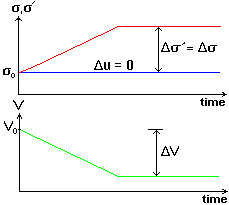Drainage and volume change
Solid soil grains are very stiff: their volume change under load can be
ignored. Water or air can be squeezed out of soil under load. The loss
of water from the soil is called drainage. The grains are rearranged and
the volume of voids reduced.
Consider a volume (V) of soil in equilibrium under a constant total stress:
Initially the total stress is so
and the pore pressure is uo:
effective stress = s´o
= so - uo,
Immediately after loading the total stress is increased by Ds:
There is no volume change and so Ds´ = 0
However, Ds´ = Ds - Du = 0
Hence, Du = Ds
Some time after loading drainage will have occurred:
A volume of water flows out of the soil (DVw)
The pore pressure increase (Du) is dissipated
Eventually Du = 0 again and the volume of
the soil has decreased by DV
Finally then:
The effective stress has increased by Ds
The volume has decreased by DV
|
Click the hypertext links to change the diagram

|
|
If drainage cannot take place when a soil is loaded the volume cannot change.
In the oedometer test porous stones are placed
above and below the sample, so that drainage is two-way: upward and downward.
Under a concrete foundation drainage may only
take place downward.
In an embankment layers of sand can be placed
to speed up drainage and thus changes in volume.
The installation of vertical sand drains,
called sandwicks, can further speed up volume change in embankments by
allowing horizontal radial drainage.
|
Click the hypertext links to change the diagram

|
 The rate of drainage
of water from soil depends on the permeability. Volume change under load
takes place quickly in sands and gravels, and very slowly in clays. Seepage
is driven by the excess pore pressure and as this is dissipated the rate
of seepage slows down. Thus, the rate of volume change is fast to begin
with, but slows down with time.
The rate of drainage
of water from soil depends on the permeability. Volume change under load
takes place quickly in sands and gravels, and very slowly in clays. Seepage
is driven by the excess pore pressure and as this is dissipated the rate
of seepage slows down. Thus, the rate of volume change is fast to begin
with, but slows down with time.
The volume-change/time curve is exponential. A simple approximate rule
is: "half the total volume change occurs in one-tenth of the total time".
In saturated soil volume changes can only occur as drainage occurs and
as effective stresses change. In unsaturated soils volume change is due
to changes in water and air volume; both of which can change without change
in effective stress.
Compaction, in which air is expelled, can occur due to vibration
(e.g. from traffic, machinery, piling, etc..); also, loosely-placed fill
can compact under its own weight.
Shrinking and swelling can occur in some clays near the surface
due to climatic changes (shrinking in summer, swelling in winter).
Creep occurs in some clay soils due to gradual changes in fabric.
Drained and undrained loading
| Top
|
The relative rates of the increase of total stress and drainage are of
critical importance in determining soil behaviour and predicting future
conditions and changes.
If the rate of drainage is quicker than the rate of loading,
effective stress and volume changes occur quickly - these are called drained
loading conditions. In drained loading the pore pressures are always
in equilibrium - if construction stops the pore pressures will remain constant
and there are no more volume changes.
If the rate of drainage is slower than the rate of loading, the
pore pressure increases and the effective stress and volume remain unchanged
- these are undrained loading conditions. In undrained loading of
saturated soil there is no volume change - if construction stops the excess
pore pressures dissipate, consolidation occurs then the volume changes.
 Under fully drained conditions the pore
pressure does not change,
Under fully drained conditions the pore
pressure does not change,
Du = 0 and
Ds´ = Ds
Thus, volume decrease will follow loading increase, i.e. increase in
total stress.
Drained loading conditions may be assumed to occur when either the soil
has a high permeability (e.g. in sands and gravels), or the loading rate
is slow (e.g. natural erosion).
Transient conditions (0 < Du < Ds)
are complex; in design it is necessary to assume either fully drained or
undrained conditions.
 Under undrained
conditions there can be no volume change, since water cannot escape.
Under undrained
conditions there can be no volume change, since water cannot escape.
From a practical point of view undrained loading occurs: in a laboratory
test (e.g. triaxial) when drainage is prevented; and in field situations
where loading changes occur quickly on soils of low permeability.
- In a saturated soil, the increase in total stress produces an equal
increase in pore pressure:
- Du = Ds and
- u = uo + Du
- As drainage occurs, u decreases and so does the volume.
At an elapsed time t:
- ut = uo + Dut,
- Ds´t = Ds - Dut and
- Vt = Vo - DVt
- Eventually, when all of the excess pore pressure has dissipated, equilibrium
is regained and steady-state pore pressure conditions prevail:
- Du = 0,
- u = uo and
- s´ = s´o + Ds
The dissipation of excess pore pressure, accompanied by volume change is
called consolidation. Usually (but not always) the total stress
remains constant (e.g. under a foundation) and the pore pressure and volume
slowly change. The rate of consolidation (volume change with seepage) is
dependent on the permeability of the soil and the size of the consolidating
layer.
Transient undrained conditions prevail during consolidation, but eventually,
when all of the excess pore pressure has been dissipated, conditions are
the same as those for drained loading.
Swelling will occur during unloading as water is sucked back
into the soil.
In any geotechnical calculation (analysis or design) it is important to
distinguish between drained and undrained loading - soils behave quite
differently in the two sets of conditions. In making this distinction it
is the relative rates of loading and seepage that must be considered.
Seepage rates depend on the
coefficient of permeability
which is related mainly to grain size: For
design purposes it is common to assume quick seepage in coarse soils and
slow seepage in fine soils.
| soil type |
coeff. of permeability (k) |
seepage rate |
| gravel | > 10-2 | very quick |
| sand | 10-2 ~ 10-5 | quick |
| silt | 10-5 ~ 10-8 | slow |
| clay | < 10-8| very slow | |
Different rates of loading arise from different natural events
or construction operations. Very rapid loading rates may occur in earthquakes,
due to piling and due to wave action.
| Event/Operation | Duration |
| Shock wave - piling | < 1 | s |
| Shock wave - earthquake | 1 - 2 | s |
| Wave breaking against wall | 5 - 10 | s |
| Trench excavation | 1 - 3 | hours |
| Small building foundation | 5 - 20 | days |
| Large excavation or building | 1 - 6 | months |
| Construction of dam or embankment | 1 - 3 | years |
| Filling of reservoir | 2 - 5 | years |
| Natural erosion | > 50 | years |


 The rate of drainage
of water from soil depends on the permeability. Volume change under load
takes place quickly in sands and gravels, and very slowly in clays. Seepage
is driven by the excess pore pressure and as this is dissipated the rate
of seepage slows down. Thus, the rate of volume change is fast to begin
with, but slows down with time.
The rate of drainage
of water from soil depends on the permeability. Volume change under load
takes place quickly in sands and gravels, and very slowly in clays. Seepage
is driven by the excess pore pressure and as this is dissipated the rate
of seepage slows down. Thus, the rate of volume change is fast to begin
with, but slows down with time.
 Under fully drained conditions the pore
pressure does not change,
Under fully drained conditions the pore
pressure does not change,
 Under undrained
conditions there can be no volume change, since water cannot escape.
Under undrained
conditions there can be no volume change, since water cannot escape.